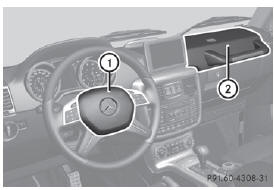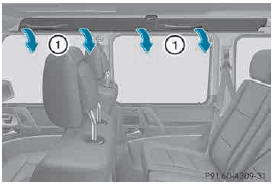Air bags
Important safety notes
WARNING
Air bags are designed to reduce the potential
of injury and fatality in certain
• frontal impacts (front air bags) • side impacts (window curtain air bags)
However, no system available today can completely eliminate injuries and fatalities.
Deployment of the air bags temporarily releases a small amount of dust from the air bags. This dust, however, is neither harmful to your health, nor does it indicate a fire in the vehicle. The dust might cause some temporary breathing difficulty for people with asthma or other breathing trouble. To avoid this, you may wish to get out of the vehicle as soon as it is safe to do so. If you have any breathing difficulty but cannot get out of the vehicle after the air bag inflates, then get fresh air by opening a window or door.
WARNING
To reduce the risk of injury when the front air
bags inflate, it is very important for the driver
and front passenger to always be in a properly
seated position and to wear their respective
seat belt.
For maximum protection in the event of a collision always be in normal seated position with your back against the seat backrest.
Fasten your seat belt and make sure it is properly positioned on your body.
Since the air bag inflates with considerable speed and force, a proper seating position and correct positioning of the hands on the steering wheel will help to keep you at a safe distance from the air bag. Occupants who are not wearing their seat belt, are not seated properly or are too close to the air bag can be seriously injured or killed by an air bag as it inflates with great force instantaneously: • Sit with the seat belt properly fastened in a position that is as upright as possible with your back against the seat backrest.
• Move the driver's seat as far back as possible, still permitting proper operation of vehicle controls. The distance from the center of the driver's chest to the center of the air bag cover on the steering wheel must be at least 10 inches (25 cm) or more.
You should be able to accomplish this by adjusting the seat and steering wheel. If you have any difficulties, please contact an authorized Mercedes-Benz Center.
• Do not lean your head or chest close to the steering wheel or dashboard.
• Keep hands on the outside of the steering wheel rim. Placing hands and arms inside the rim can increase the risk and potential severity of hand/arm injury when the driver front air bag inflates.
• Adjust the front passenger seat as far as possible rearward from the dashboard when the seat is occupied.
• Occupants, especially children, should never place their bodies or lean their heads in the area of the door where the window curtain air bag inflates. This could result in serious injuries or death should the window curtain air bag be deployed. Always sit as upright as possible, wear the seat belt properly and use an appropriately sized infant restraint, toddler restraint, or booster seat recommended for the size and weight of the child.
• Children 12 years old and under must never ride in the front seat, except in a Mercedes- Benz authorized BabySmart™ compatible child seat, which operates with the BabySmart™ air bag deactivation system installed in the vehicle to deactivate the front passenger front air bag when it is installed properly. Otherwise they will be struck by the air bag when it inflates in a crash. If this happens, serious or fatal injury will result.
Failure to follow these instructions can result in severe injuries to you or other occupants.
If you sell your vehicle, it is important that you make the buyer aware of this safety information. Be sure to give the buyer this Operator's Manual.
WARNING
Accident research shows that the safest place
for children in an automobile is in a rear seat.
Should you choose to place a child 12 years old or under in the front passenger seat of your vehicle, you must properly use a BabySmartTM child restraint which will turn off the front passenger front air bag.
To help avoid the possibility of injury, please follow these guidelines: (1) Always sit as upright as possible, wear the seat belt properly, and for children 12 years old and under, use an appropriately sized infant restraint, toddler restraint, or booster seat recommended for the size and weight of the child.
(2) Always wear seat belts properly.
If the air bags are deployed, you will hear a
bang, and a small amount of powder may also
be released. Only in rare cases will the bang
affect your hearing. The powder that is
released generally does not constitute a
health hazard. The  SRS warning lamp
SRS warning lamp
lights up.
The air bags are deployed if the air bag control unit detects the need for deployment. Only in the event of such a situation will the air bags provide their supplemental protection.
If the driver and front passenger do not wear their seat belts, it is not possible for the air bags to provide their supplemental protection.
In the event of other types of impacts and impacts below air bag deployment thresholds, the air bags will not deploy. The driver and passengers will then be protected to the extent possible by a properly fastened seat belt. A properly fastened seat belt is also needed to provide the best possible protection if the vehicle rolls over.
Air bags provide additional protection; they are not, however, a substitute for seat belts.
All vehicle occupants must fasten their seat belts regardless of whether your vehicle is equipped with air bags or not.
It is important for your safety and that of your passengers to have deployed air bags replaced and to have any malfunctioning air bags repaired. This will help to make sure the air bags continue to perform their protective function for the vehicle occupants in the event of an accident.
Front air bags
WARNING
Observe "Important safety notes"
.
WARNING
Your vehicle is equipped with air bag
technology which disables the frontpassenger
air bag if the system recognizes
that the front-passenger seat is empty .
If the front-passenger seat is occupied by an
adult or young person and the 
indicator lamp is lit up, the front-passenger air
bag is disabled. If the front-passenger seat is
recognized as empty, the air bag control unit
will not deploy the front-passenger air bag in
the event of a collision.
Ask your passenger to sit correctly on the
front-passenger seat in an upright position
until the  indicator lamp goes out.
indicator lamp goes out.
If the  indicator lamp does
indicator lamp does
not go
out, please consult an authorized Mercedes-
Benz Center.

Driver's air bag 1 deploys in front of the steering wheel; front-passenger front air bag 2 deploys in front of and above the glove box.
The front air bags increase protection for the driver's and front-passenger's head, neck and chest.
They are deployed:
• in the event of certain frontal impacts
• if the system determines that air bag
deployment can offer additional protection
to that provided by the seat belt
• independently of other air bags in the
vehicle
• depending on whether the seat belt is being
used
If the vehicle rolls over, the front air bags are generally not deployed. If the system detects high vehicle deceleration in a longitudinal direction, the front air bags are deployed.
Your vehicle is equipped with a dual-stage driver's air bag and a single-stage frontpassenger front air bag. In the event of a collision, the air bag control unit evaluates the vehicle deceleration. In the first deployment stage, the driver's air bag is filled with enough propellant gas to reduce the risk of injuries.
The front-passenger front air bag, however, is immediately filled with the maximum amount of propellant gas. The driver's air bag is fully deployed if a second deployment threshold is exceeded within a few milliseconds.
The lighter the front passenger, the higher the vehicle deceleration rate required (predicted at the start of the impact) for triggering the front-passenger front air bag.
The front air bags will not deploy in impacts with vehicle deceleration or acceleration rates which do not exceed the system’s preset deployment thresholds for vehicle deceleration or acceleration. You will then be protected by the fastened seat belt.
Front-passenger front air bag 2 will only
deploy if:
• the front-passenger seat is occupied.
• the  indicator lamp on the center
indicator lamp on the center
console is not lit
• the impact exceeds a preset deployment
threshold
The front-passenger air bag is automatically activated and deactivated. Both driver and passenger should always check whether the front-passenger air bag is activated or deactivated.
The deployment of the driver's air bag does not mean that the front-passenger air bag will also deploy. If the system recognizes that the front-passenger seat is empty, the frontpassenger air bag does not deploy even if the impact fulfills the criteria and the driver's air bag has deployed.
If the system detects that the front-passenger
seat is occupied, the  indicator
indicator
lamp lights up for approximately six seconds
if:
• you turn the SmartKey to position 1 or 2 in
the ignition lock.
• the engine is running and then you switch it off.
This indicates the operational readiness of the front-passenger air bag.
Note that objects placed on the frontpassenger
seat may cause the system to
recognize the seat as occupied. This can
result in the deployment of the frontpassenger air bag if the impact fulfills
the
specified criteria. If the 
indicator
lamp lights up, the front-passenger front air
bag is disabled and will not be deployed in
certain situations. If the 
indicator
lamp does not light up, the front-passenger
front air bag is enabled and can be deployed.
Window curtain air bags
WARNING
Observe "Important safety notes"
.

Window curtain air bags 1 enhance the level of protection for the head, but not chest or arms, of the vehicle occupants on the side of the vehicle on which the impact occurs.
Window curtain air bags 1 are integrated into the side of the roof frame and deploy in the area extending from the front door (Apillar) to the rear door (C-pillar).
Window curtain air bags 1 are deployed:
• on the side on which an impact occurs
• at the start of an accident with a high rate
of lateral vehicle deceleration or
acceleration, e.g. in a side impact
• regardless of whether the front-passenger
seat is occupied
• independently of seat belt use
• if the vehicle rolls over and the system
determines that window curtain air bag
deployment can offer additional protection
to that provided by the seat belt
• independently of the front air bags
Window curtain air bags will not deploy in
impacts which do not exceed the system's
preset deployment thresholds for lateral
acceleration/deceleration. You will then be
protected by the fastened seat belt.
See also:
MOExtended tires (tires with run-flat
properties)
General notes
With MOExtended tires (tires with run flat
characteristics), you can continue to drive
your vehicle even if there is a total loss of
pressure in one or more tires. The affected
tire ...
Qualified specialist workshop
An authorized Mercedes-Benz Center is a
qualified specialist workshop. It has the
necessary specialist knowledge, tools and
qualifications to correctly carry out the work
required on your vehicle. ...
Overhead control panel
1 Voice Control System only available together with COMAND. Observe the
additional operating instructions. ...
